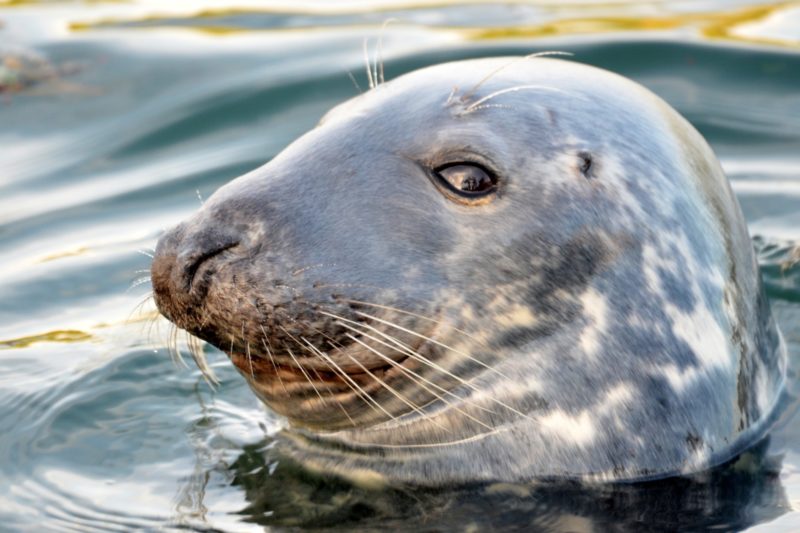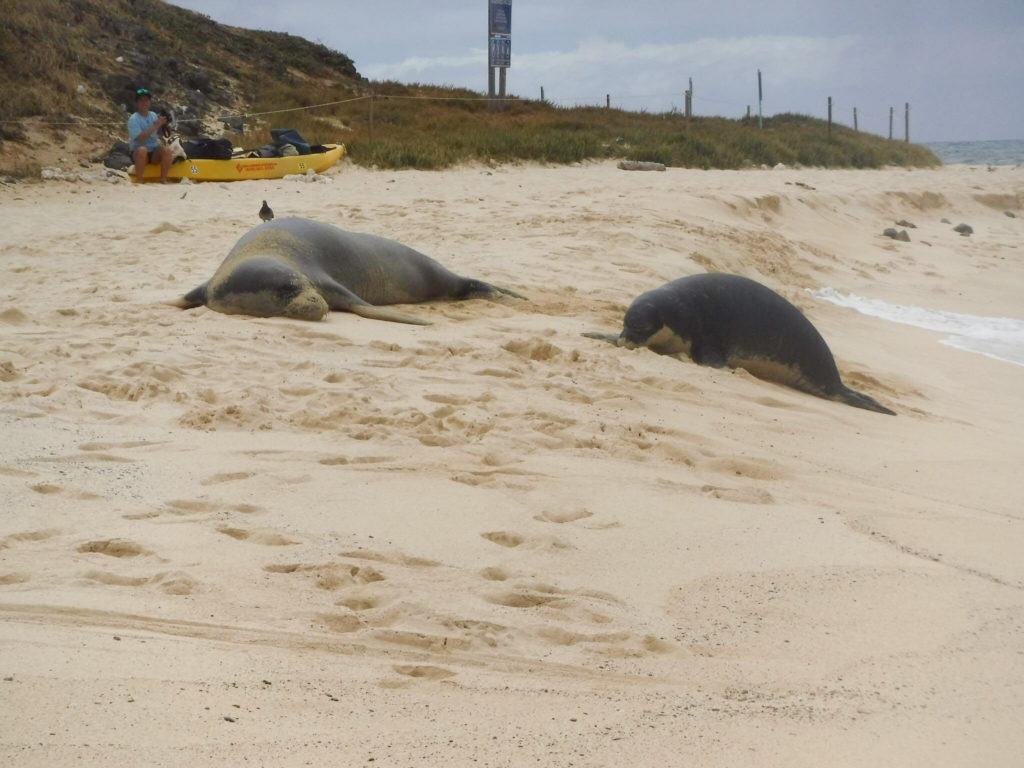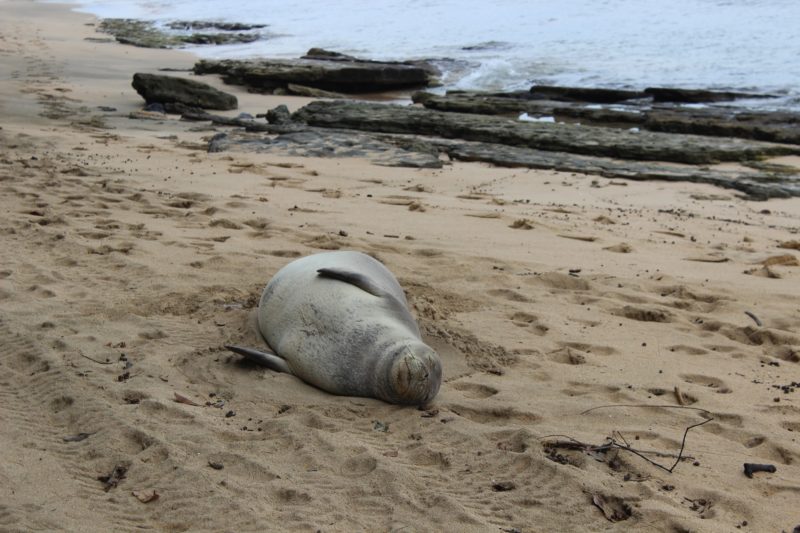The Hawaiian Monk seal holds a unique significance in Hawaii. To begin with, it is one of only two native species found exclusively in Hawaii, the other being the Hoary bat. The Seal’s official name is “Monachus schauinslandi” which is known in Hawaiian as ‘ilio holo i ka uaua – the dog that goes in rough water. These distinctions make them loved and revered in Hawaii, so much so that many volunteer organizations are prepared to follow the seal’s every move and protect them when they come to shore. The largest populations of monk seals are found in the Northwestern Hawaiian Islands, which have been granted additional federal protection as the Papahanaumokuakea Marine National Monument. Hawaiian monk seals are dark gray or brown and can weigh between 375 and 500 pounds — another reason to stay out of their way! You can usually find them alone, lying on the beach or swimming in the water.
Protecting the Hawaiian Monk Seal
Hawaii’s unwavering dedication to safeguarding the Monk Seal is rooted in the fact that this species teetered on the brink of extinction in 2016, with just 1,200 remaining, and it continues to be classified as endangered. As of 2023, only 1,570 Monk Seals have been reported in the Hawaiian Islands. The significant decline in the seal population can be attributed to various factors, including the impact of parasites and overfishing. Additionally, the seals have slow reproductive rates and are subject to losses from shark predation.
Efforts to track the seal population around the main islands continue through cooperative projects involving NOAA Fisheries, National Marine Fisheries, the Hawaiian Islands Humpback Whale National Marine Sanctuary, the state Aquatics Resources Division, and volunteer research groups such as the Hawaii Wildlife Fund. For over twenty years, NOAA has diligently monitored monk seals across the Hawaiian Archipelago as a vital component of their broader mission to study and safeguard this vulnerable seal species. If you’re interested in seeing the movement of these special creatures, you can track them here at the integrated Ocean Observing System
Conservation efforts have increased the size of the monk seal population. To continue to protect Hawaiian monk seals and for your safety, the National Marine Fisheries Service tells us to stay at least 150 feet away from them, whether they are on the beach or in the water. They often come up to the beach to rest for long periods. Don’t disturb their rest, and don’t feed them or touch them. But again, take as many pictures as you want! Oftentimes, when a Hawaiian Monk Seal is sighted, volunteers will put up signs and patrol the area asking people to stay away – that’s how rare they are.
Hawaiian Monk Seal and Social Media

A recently released study by the National Oceanic and Atmospheric Administration (NOAA) examines the possible effects of social media enthusiasts posing with the lovable creatures on the overall population in the Hawaiian Islands. The study examined nearly 2,400 social media (Instagram) posts with the #monkseal hashtag. The study says that the popularity of handheld devices like smartphones with high-resolution cameras can provide valuable information to scientists studying endangered species like the Hawaiian monk seal.
The NOAA looked at images posted in one year. They took biological and location information (thanks to GPS meta-data), behavioral concerns, human disturbance, and public perceptions about the unique Hawaiian species. The information in the study indicates that social media is a valuable tool in conservation and protection efforts for rare or endangered species worldwide.
There is good news in the study: social media can help scientists study and protect populations like the Hawaiian monk seal and others. However, some of the data has caused concerns about up-close interactions with monk seals, which can have negative effects, too.
For example, of the nearly 2,400 posts studied, 22% showed people within 3 meters of a monk seal. That is far more than the 50-meter distance recommended by the NOAA and other agencies and organizations that monitor the species. 17% of the images indicated a disturbance to the animal. Combined with increased Hawaii visitor numbers and ubiquitous “selfie” enthusiasts, this means that there is increasing potential for disruptions of animals that are just trying to relax on the beach. Disturbing a monk seal could send it back into the ocean without having slept enough or warmed up enough.
If you don’t get to see them in the wild, the Waikiki Aquarium has both Hawaiian monk seals and Hawaiian green sea turtles. To see these two unique animals alone makes the zoo worth the trip.

Tips when encountering a Hawaiian Monk Seal
- Restrict your viewing time to a few minutes.
- Follow signage and boundaries and never cross over the line.
- Never chase or swim near a Monk seal or pups.
- Don’t touch a Monk Seal.
- Never Feed Monk Seals.
- If you spot a Monk Seal, contact officials at the DNLR by calling 808.853.3567
How you can Help
- Help maintain clean beaches.
- Practice the principles of reduce, reuse, and recycle.
- Respect the natural habitat of seals—provide them with space.
- While fishing, retrieve your fishing line when a seal is in the area.
- Keep pet cats indoors exclusively to prevent the spread of the Toxoplasma gondii parasite, which threatens monk seals and native wildlife.
- Volunteer with the Marine Mammal Center
We’re here to help, check out our All-Inclusive Hawaii Packages or get help with airfare, picking hotels or activities. If it’s in Hawaii we can make it happen.
Get Help With Planning



